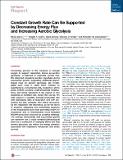Constant Growth Rate Can Be Supported by Decreasing Energy Flux and Increasing Aerobic Glycolysis
Author(s)
Slavov, Nikolai; Budnik, Bogdan A.; Schwab, David; Airoldi, Edoardo M.; van Oudenaarden, Alexander
Download2014_Slavov_Cell with SI.pdf (2.419Mb)
PUBLISHER_CC
Publisher with Creative Commons License
Creative Commons Attribution
Terms of use
Metadata
Show full item recordAbstract
Fermenting glucose in the presence of enough oxygen to support respiration, known as aerobic glycolysis, is believed to maximize growth rate. We observed increasing aerobic glycolysis during exponential growth, suggesting additional physiological roles for aerobic glycolysis. We investigated such roles in yeast batch cultures by quantifying O[subscript 2] consumption, CO[subscript 2] production, amino acids, mRNAs, proteins, posttranslational modifications, and stress sensitivity in the course of nine doublings at constant rate. During this course, the cells support a constant biomass-production rate with decreasing rates of respiration and ATP production but also decrease their stress resistance. As the respiration rate decreases, so do the levels of enzymes catalyzing rate-determining reactions of the tricarboxylic-acid cycle (providing NADH for respiration) and of mitochondrial folate-mediated NADPH production (required for oxidative defense). The findings demonstrate that exponential growth can represent not a single metabolic/physiological state but a continuum of changing states and that aerobic glycolysis can reduce the energy demands associated with respiratory metabolism and stress survival.
Date issued
2014-04Department
Massachusetts Institute of Technology. Department of Biology; Massachusetts Institute of Technology. Department of Physics; Koch Institute for Integrative Cancer Research at MITJournal
Cell Reports
Publisher
Elsevier
Citation
Slavov, Nikolai, Bogdan A. Budnik, David Schwab, Edoardo M. Airoldi, and Alexander van Oudenaarden. “Constant Growth Rate Can Be Supported by Decreasing Energy Flux and Increasing Aerobic Glycolysis.” Cell Reports 7, no. 3 (May 2014): 705–714.
Version: Final published version
ISSN
22111247